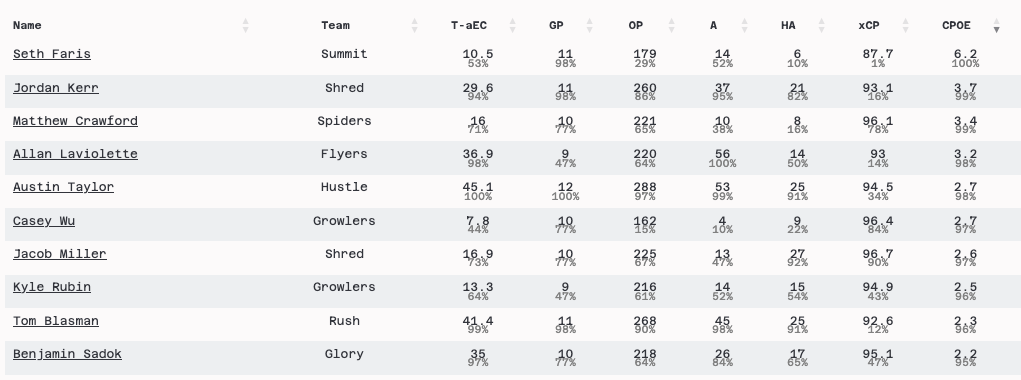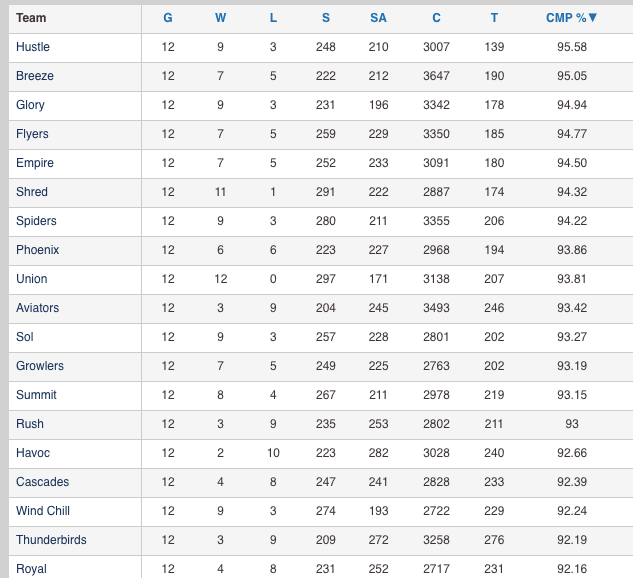What do you think of the Tom Blasman hammer? asks Evan Lepler.
I'm glad you asked! (Bryan Jones's answer, by the way: "There was enough space for it! I'm not sure it was the most necessary thing in the world, but it worked out.")
I've been enjoying watching UFA rookie Tom Blasman of the Toronto Rush throw hammers this year. One of them was featured in a recent post.
I thought it'd be interesting to go back and track how he did throwing hammers this year. There's a fair amount of discussion around whether upside-down throws are inherently risky (for example—"not the most necessary thing in the world, but it worked out"). But I'm not aware of any hard data on hammer1 completion percentages. This post is perhaps the first time we've had that data2. [Update (2025-08-07): See the comments from Jim Parinella below this article for more data on hammer completion rates.]
If you'd like to double-check my work, all the data is in this Google Sheet. Here's what I found:
On the season, Blasman was 38 of 46 on hammer attempts. However, this includes four incomplete End-Of-Quarter (EOQ) heaves, and one close-to-perfect throw that was dropped. If you remove those five attempts (as any reasonable analyst would), he was 38 of 41 on hammer attempts — 92.7%.
Those 38 completions produced 11 assists, 8 hockey assists, and roughly 805 yards (~21 yards per completion3).
Shown Space rates Blasman as one of the three or so most valuable throwers in the UFA this year. His raw numbers are pretty great (45 assists on the season, 25 hockey assists), but I suspect one reason the model likes him so much is the hammers—they both:
get the disc into open space on the breakside where continuation is often very easy, and,
get the team out of dangerous situations on the sideline.
For example, the clip below was his last completed hammer of the season. It was neither an assist nor a hockey assist...but it was pretty much trivial for the Rush to score once the hammer was completed:
This hammer is similar: it didn't generate any stats, but the disc also never leaves the breakside between the hammer being completed and the Rush scoring:
He has the lowest completion percentage of any of the top 10 throwers on Shown Space, and the most turnovers, but the model says the reward is more than worth the risk.

They also have him as one of the top ten or so throwers in terms of Completion Percentage Over Expectation:
I'm too lazy to calculate the exact league-wide completion percentage, but by eyeballing the UFA's stats page, it looks like it's right around 93%. The Rush finished 14th in the league in completion percentage, at 93%. Or to compare to individual players: Blasman's completion percentage on hammers was higher than the completion percentage on all throws by players like Travis Dunn, Chad Yorgason, or Calvin Brown4.
For me, that's the main takeaway here—a good thrower can complete upside-down throws at the league's average completion rate for all throws. And given how they open up the field, hammers are likely still good offense even if they're completed at a rate somewhat below the league average for all throws...If anything, Blasman probably should've thrown more hammers this year.
I think discouraging players from learning hammers is doing the game a disservice. If you haven't seen it, I also recommend the Pod Practice episode with Boston Celtics analyst Chris Bubernak, where he says he thinks that if truly elite athletes played frisbee, they would just throw hammers all the time (“it would destroy the entire [concept of] breakside and force side”, he says, “…you can put them anywhere on the field”):
(You'll have to rewind a couple minutes to hear the original question)
Of course, I don't suggest skipping the "get really, really good at throwing hammers" step in the process. If you're not good at throwing hammers, hammers are not a good throw. But skilled throwers can complete hammers at a rate matching any other throw.
A few more findings/stray thoughts from the data I recorded:
8 of his hammers were thrown down the same sideline. We usually think of hammers as being crossfield throws, but sometimes the "open side hammer" can be useful too5—it makes it trivial to get the disc over the defense.
Only 5 of his hammers were thrown to escape double teams. To be honest, this is less than I would've expected. However I also counted 6 throws that were thrown to escape the sideline but not against a double team. My intuition is UFA teams may be learning that the sideline double team isn't as effective as they would've hoped—it's too easy to throw out of it and leave the defense scrambling playing 5-on-6. However, teams still think sideline roller pulls are a useful strategy—just with a single mark defender and hard defense elsewhere.
Out of a double team:
Out of a sideline pull, non-double-team:
I'm a fan of the "random hammer that didn't 'need' to be a hammer". Why bother pivoting around a defender when you could just throw it right over their head?
The stereotypical right-handed hammer is a break throw thrown from the right side of the field to the left (using the offense's perspective when facing towards the goal they're trying to score in). Two of the three "real incompletion" Blasman hammers this season came when throwing a hammer from the left side of the field to the right—opposite of the typical hammer situation—including one that was D'ed on an MVP-level play by MVP Jeff Babbitt.
The sample size is obviously too small to actually make anything of it, but if there's one possible area for improvement, it's here.He only threw four hammers in the first three games; after that he threw 42 in the last 9 games, an average of almost 5 per game. His season high for attempts was 9 in Toronto's home game against Boston, with 8 completions and the Jeff Babbitt D shown above. At one point in the game the announcer claimed "Blasman's thrown five throws and they're all hammers". It wasn't literally true but I can understand why it felt that way.
I didn't record any data, but the scoober game was on point, too, so please enjoy one last highlight before we go:
Or scoober, etc
If you know of any others, shoot me a link and I'll update the post
I used the method the NFL uses, which I assume the UFA does too, that no “extra credit” is given for passes that land deep in the endzone. E.g. a pass thrown from a spot 25 yards from the end zone that lands 12 yards past the goal line is worth 25 yards, not 35.
Admittedly they surely also have some end-of-quarter heaves that haven’t been filtered out of their raw stats.
As mentioned in the comments of the stall zero hammer post


My team in spring 1991 (Nationals the previous two years) completed* (7000 passes total)
95% backhand
92% forehand
92% "other" (primarily hammers but would include push passes or lefties or scoobers or whatever) (only one guy threw scoobers and a different guy occasionally dumped lefty)
94% overall on non-long
60% hucks
1.64 ratio of backhands to forehands
*1.8% of passes were dropped but were recorded as completions for the thrower.
1992 team, lost in finals of Nationals:
96% backhand
94% forehand
91% hammer
95% overall on non-long
61% long
1.5% drop
1.43 backhand to forehand
Note that man defenses were almost exclusively force middle then. Almost all dumps were backhands. But there were no cross-body backhands to the forehand side because the marker was closer and the throw couldnt' get off.
I'd point out that hammers are probably dropped more frequently than flat passes, especially fast ones, especially ones with a defender closing. I wouldn't have been surprised if that second clip wasn't caught (though not sure if it would have been classified a drop or a throwaway; in most cases where the disc contacts the receiver and isn't caught, there is a mix of blame between thrower and receiver. I/Os are also probably "dropped" more than average since they can come in fast and with the opposite spin in front of (vs directly at) a player in stride and the player can't use the body to cushion.).
That said, I think you're on the right track.
how did you all track these stats? was somebody counting them during live gameplay?